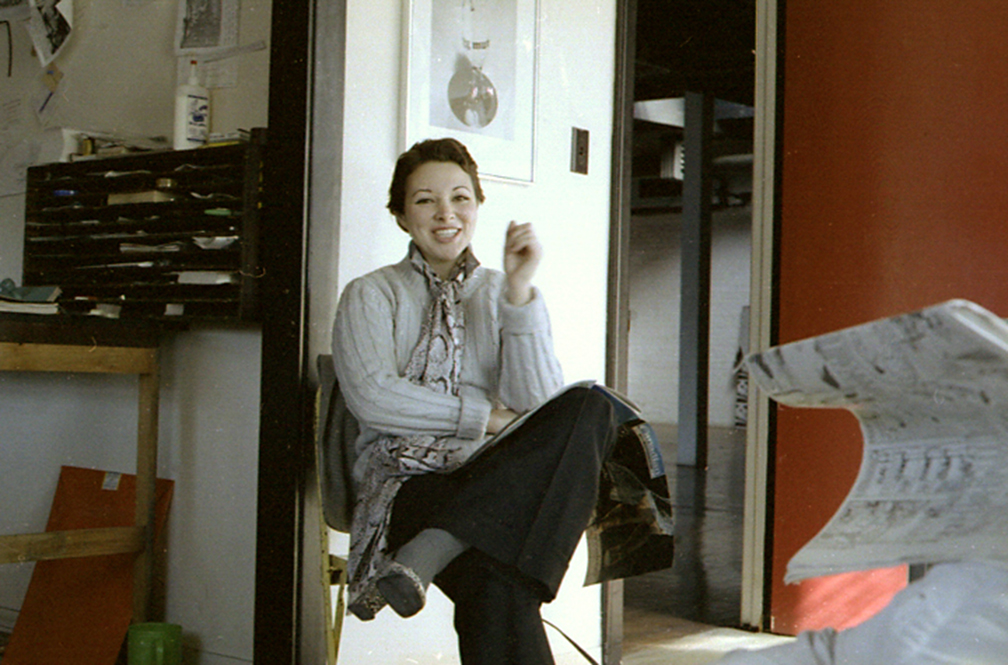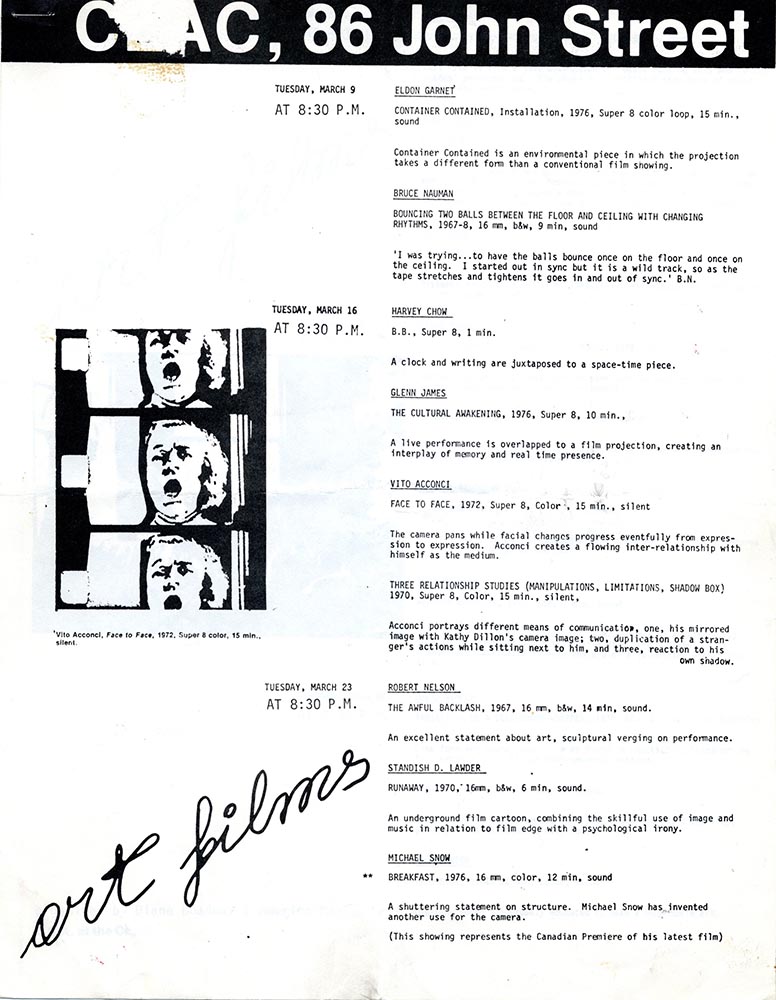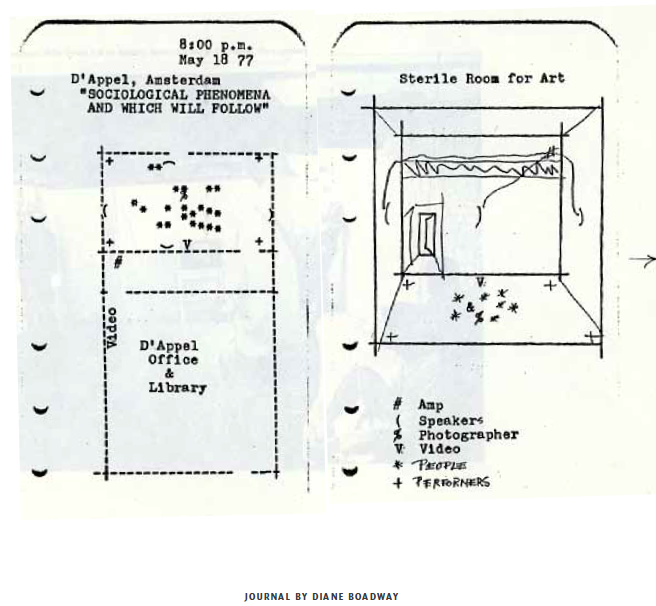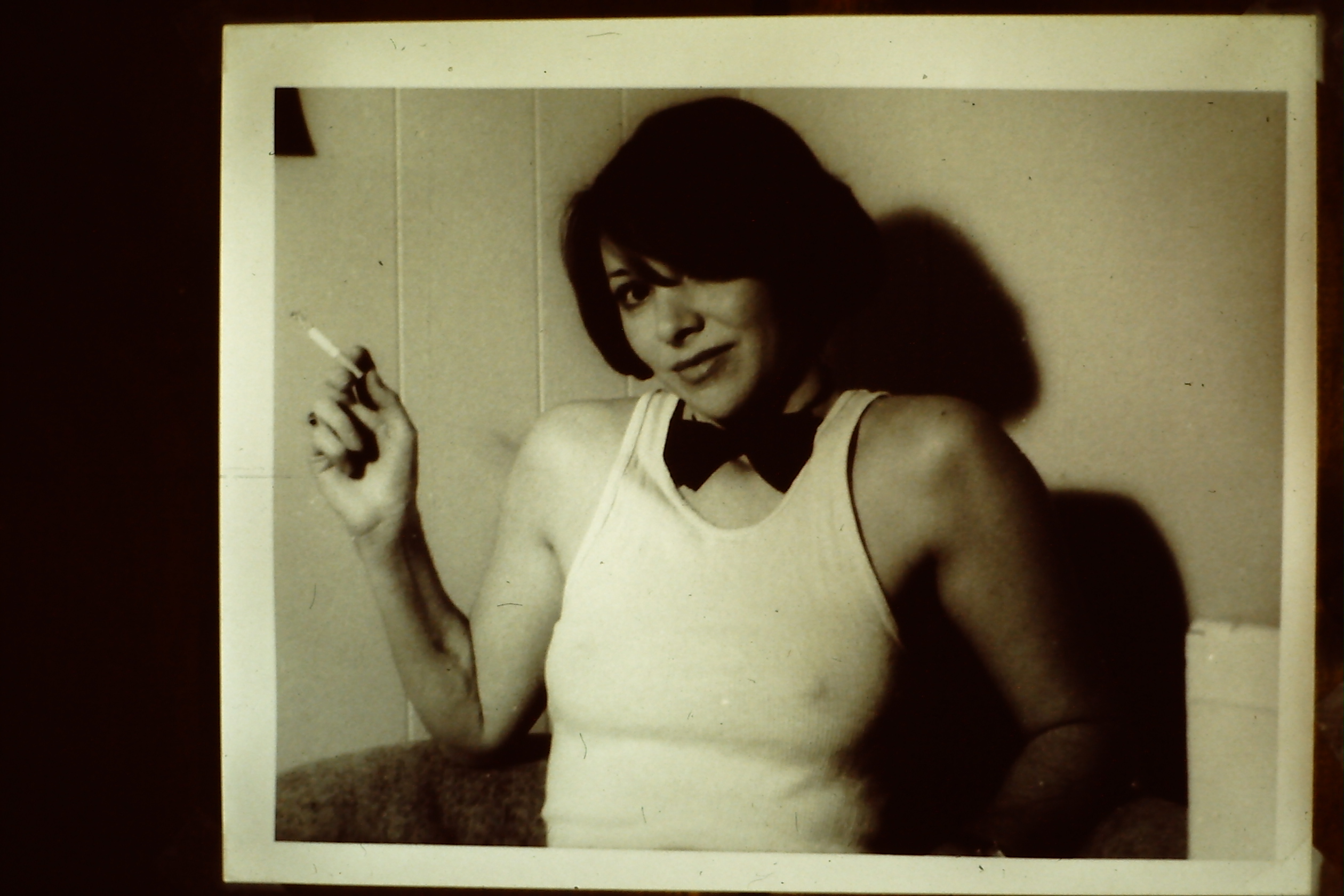Beginnings
I was fortunate back at the Ontario College of Art, to find and be rocketed by fourth year conceptual art classes offered by Joyce Zemans. However, I first experienced the experimental film world from inside out. Through an acquaintance with Mike Snow, I was asked to be in two of his films Rameau’s Nephew by Diderot (Thanx to Dennis Young) by Wilma Schoen (1974) and Two Sides to Every Story (1974). Also at that time I had met Peter Dudar and was invited by him to be in performances of his with Missing Associates. As you know Peter’s performance work is “structurally filmic.”
Amerigo Marras actually invited Lily Eng and I to the Kensington Art Association to help work in the gallery. He had seen me in performances by Missing Associates and had been really impressed with Peter and Lily’s performance art (which was very important, being some of the first performance art work done in Canada at the time). I had thought to do evening art events for some time before meeting Amerigo, and the film programming was an opportunity which Amerigo was interested in, of course, for the new John Street location where the film program started.
There were no venues for experimental film in Toronto, but I remember seeing independent films in New York which made an impact. Regarding where the films came from – initially I went to the Canadian Filmmakers Distribution Centre in Toronto, viewing films in the screening room, until I found something which I felt would fit the particular evening. Of course, as the events became more known there were lots of submissions particularly from artists at OCADU and video artists. And I also remember certain incidences of animosities when artists were not chosen for a program.
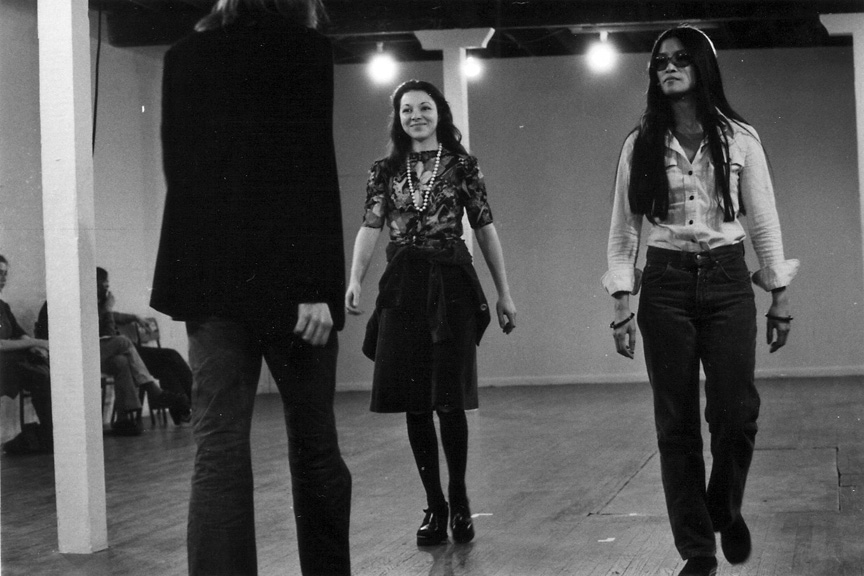
“Two Related Parallel Lines, If I Can Remember” Concept: Peter Dudar. Performers: Peter Dudar, Diane Boadway, Lily Eng, A Space, 1975
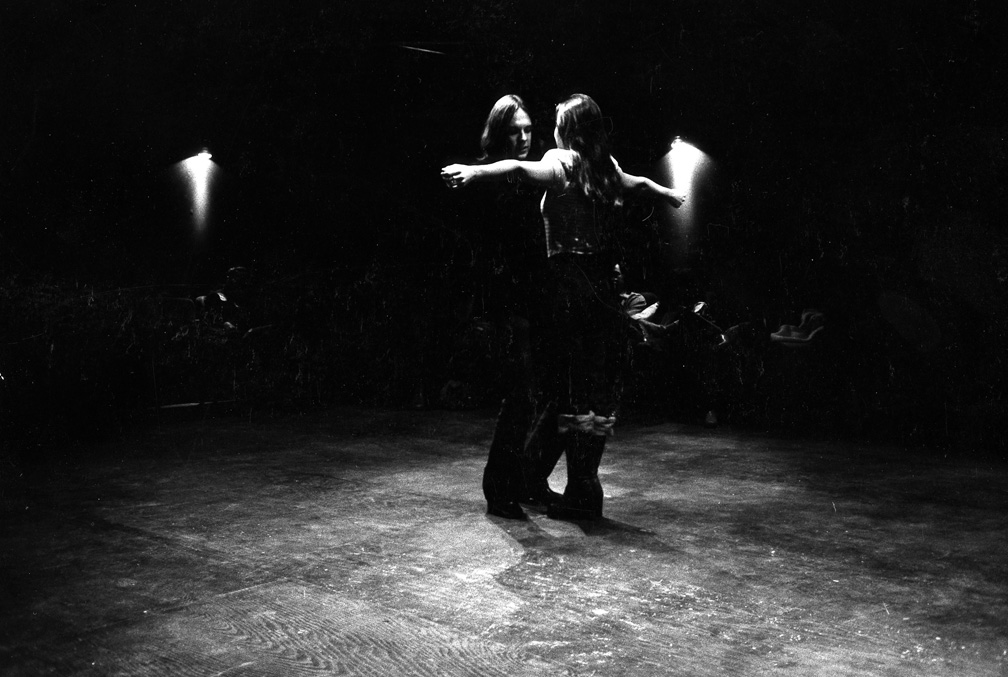
“Establishing Equal Grounds For Mutual Support” (version 2, 1975). Concept: Peter Dudar. Performers: Peter Dudar, Diane Boadway. 15 Dance Lab, Toronto
I suggested to Amerigo that I do the programming and would curate independent experimental art films and video works and run advertising for them. In late 1975 and 1976 I curated a film and video program for Amerigo Marras at two CEAC locations: John Street and then 15 Duncan Street and Ross McLaren’s work was included. Ross McLaren was subsequently handed the programing role which led to the founding of The Funnel. Regarding Ross being handed the film programming, I’m not sure exactly how that happened. Ross would have the details.
Which will follow
In early 1977 I approached Amerigo Marras about doing a performance art piece at CEAC. It integrated my interests in political art and provocative intentions with critical, analytical content. The structural art premise was to have four performers holding microphones and wearing speakers on their chests which would project the performers’ voices while arranging audience and performers in a unique manner.
This art performance was called Sociological Phenomena and Which Will Follow and created a unique structural space with technology, audience, and performance artists, and was designed to question the usual theatrical arrangement with the audience’s role as voyeur/participant, as they would be interrogated/questioned with statements. The performers were myself, Bruce Eves, Amerigo Marras and Suber Corley. Bruce Eves wrote most of the text for the performances from Toronto and through Europe.
Amerigo liked the piece when we performed it in Toronto. He then suggested that we tour it in Europe. Which Will Follow formed the basis for the performances done on the 2nd CEAC European tour in 1977. The performers’ placements and text morphed as we went along through Holland, Poland and Italy, but the concepts of the four characters placed in varying locations in the art space and voicing socio/political texts through/to each other, questioning the audience, was derived from this piece. Sociological Phenomena and Which Will Follow had its European launch in Amsterdam and then became the model for ten others we devised and revised in several venues during the art tour (see my diary performance description at Palazzo Diamani, Ferrara).
The audience location moved to the middle of the space in Amsterdam, which was interesting as the four performers surrounded the audience with performance/sound/language. The logic of placement continued to change in every city. Amerigo and Bruce had input into the text and it became more political as we travelled deeper into the itinerary of the 1977 European art tour. My diary from the art tour explains more of the pieces performed and Bruce’s “gay political art” solo street works as well.
The content of Which Will Follow was political, questioning the state’s economic position regarding the art market, bureaucratic control and institutions versus young alienated artists. One text asked: “Who dominates our culture?” The concepts discussed the finding/orientation of audience/artist, people’s relationships, awareness, or access to things such as the mass media and the art scene. The work has obvious influences from my earlier participation in Peter and Lily’s Missing Associates performances. A provocative situation was created by sometimes directly touching people or asking them to respond, speaking through microphones, the speakers (in this case, worn by the performers) surrounding the audience, questioning the audience’s role as voyeur. The critical and analytical aspects were based on investigating the situation where we were to perform; as it stood ideologically, geographically (cultural attitudes, people’s street behavior), what level the artist seemed to be on, who was connected with this particular place and how the director functioned within the art world and with the artists. After going over the opinions of the situation (by discussion and practice), we developed a performance or anti-performance which concerned the people present; for example pointing to their naivety, trendiness, corrupt political situation or impersonal institutionalizations.
The bare loudspeakers are worn on the body facing outward, the microphones held in hand. Owing to the volume of speech, hearing is convoluted, directed towards improvisations of audience communication. They will become accustomed to being confronted, creating the need to express the innermost actions of thought.
The external situation is a mirror of the amplification in the brain to reveal the knowing and unknown. A microphone runs from amplifier to audience, this track is received in my chest. I have a microphone that runs from my speech to the performer’s loudspeaker in keeping with the alienation that turns human subjects into objects. Words in space produce vibrations through time and space that push at the boundaries of our systems of reception, enabling cultural transition. Texts are improvised out of previous discussions about specific cultural bases. Sound moves to/from, over, between, on top of, behind, through, beside, furthest from, beyond the outside of inside, and to any point.
This is a project of text for four microphones and four loudspeakers. Each performer possesses a microphone and has strapped somewhere onto their body a speaker. The tracks of loudspeakers and microphones vary. One person or performer speaks to another from his microphone to their speaker. The loudspeaker faces inward, projecting sound into the nervous system from a speaker in the audience, which is background track to the placed microphones. A project for the street is suggested: universalize a cultural pattern through interpretation.
Confrontations
I had been involved in artistic endeavours and arranging events at CEAC when the Duncan Street basement began to be used. I spent many hours in the basement’s darkroom learning camera and darkroom techniques. Learning photography skills led to my having the tools to do a major socio/art book project in 1978 called Confrontations. It is a journalistic project (placed in a fine art context), using film, as well as taped interview, and photography work. The idea was to let the person on the street, in a bar, etc., who I would approach, become the art, and to draw out sociological information. I compared interviews/tapes of selected people with an intellectual artist or curator view, allowing the idea of discovering reasons for cultural disparities.
